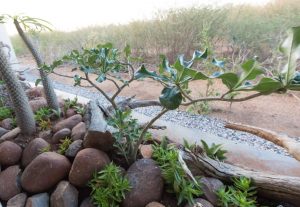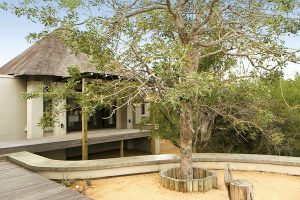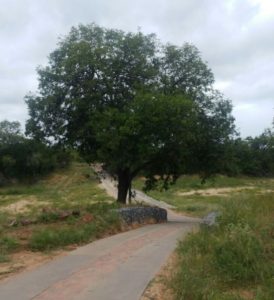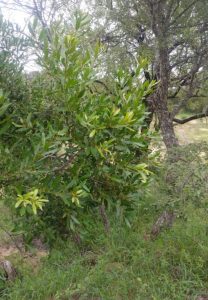Nature Natter: Gardening with Trees
• 8 March 2017
What tree to plant?
John Gear is continuing Nature Natter with some advice on gardening in a wildlife estate.
Part 1: Shade trees and Screening
I recently received a request from fellow owners (Peter & Fiona Mostert) to offer some suggestions regarding tree challenges in their Zandspruit Garden. This blog is largely based on what I suggested to them. I am grateful that they were happy for me to share this. At first I will set out some key principles when it comes to gardening in a Wildlife Estate and thereafter I will make some suggestions.
Water-demanding vs Water-wise vs No artificial watering
This is your first major decision. Plants demanding water mean that non-resident owners need to install an automatic system or arrange garden services on a weekly basis; expensive. Water-wise still requires water in a drought. Occasional visits by owner are inadequate but garden services can be less frequent. Drought of last two years has pushed me to minimal artificial intervention in existing bush! But if you are keen to water something why not water an existing tree or shrub which has already declared its willingness to try to grow on Zandspruit which actually has quite a hostile geology.
Evergreen vs deciduous
Evergreen has huge appeal on a property that is largely deciduous. In general, evergreen is more water-demanding than deciduous. There are many wonderful deciduous trees BUT no winter shade and many are quite slow growing – see below.
Invasive vs Non-invasive root systems
Beware of invasive roots near your home & pool. Figs are the major culprits but there are others; do check your particular choice.
Intensive vs minimalist
For non-resident home owners minimalist is undoubtedly the way to go. Minimalist can be as simple as pebbles, rocks & a garden ornament from the Zimbabwe roadside sellers with no greenery at all – but this blog is about trees!!

Locally indigenous vs regionally indigenous
This is a challenge. Many of the more appealing trees are restricted to perennial rivers, kloofs and higher and wetter areas. In terms of a shade tree you can be more adventurous by going regional; screens etc should ideally already be on Zandspruit but more generally I think it is wise to restrict choices to trees found in the north and east of South Africa.
Small trees vs larger trees from the Nursery
No doubt a big tree has a head start provided it is not root-bound and provided initial hole and soil quality optimal. Furthermore delicate smaller trees will need more water initially. Hole size must be a minimum of 1mx1mx1m and if an already large root system then up to 2x2x2m. Mulching is essential and mulch must be both thick and maintained.
Wild animals
Browsers and rooters are a menace; prepare for brutal prunings and some losses hence protect the precious plantings. For some reason plants in rockeries seem particularly susceptible to porcupine assault. I lost three 2-year old Phoenix reclinata (Wild Date Palm) and a number of Agapanthus in one night in 2015.
Growth Rate
If wanting quick results you are limited to fast growers which inevitably need more water. If you are young and patient it’s quite fun to see your trees and garden develop alongside your children! Slow growth<600mm per year, moderate growth 600-900mm & fast >900mm. I am talking about trees here and not kids! Remember in dry times drought resistant trees will survive but will not reach growth rate potential.
It is likely that you will be aiming at a mix of the above when planning and upgrading your garden.
Here are my suggestions with regards to trees in your garden
- Make the very most of special already existing trees by mulching and perhaps extra watering. The run off from the “septic tank” can be channeled to target trees

Trees that need to provide shade in your garden
I recommend rapid growth, evergreen, cage protection for at least 2 years, additional watering and mulch+++
- Trichelia emetica (Natal Mahogany) locally indigenous, fast growth, evergreen, only mildly invasive roots and undoubtedly best shade tree by far
Alternatives:
- Antidesma venosum (Tassel Berry) regionally indigenous, fast growth, evergreen, non-invasive roots but water hungry, single sex so need 3-4 trees if want to be fairly certain of fruiting
- Berchemia discolor (Brown Ivory) locally indigenous, moderate growth, almost evergreen, non-invasive and a great tree
- Apodytes dimidiata (White Pear) regionally indigenous, moderate growth, evergreen, non-invasive and needs some watering initially
- Schotia brachypetala (Weeping Boerbean), locally indigenous, moderate growth, evergreen, non-invasive. Spectacular tree when mature

- Galpinii transvaalica (Wild Pride-of-India) regionally indigenous perhaps locally, evergreen, fast growth, non-invasive roots
- Balanites maughamii (Greenthorn or Torchwood) locally indigenous, more deciduous than evergreen, is a slow grower and only spreads crown late
Trees you plant for screening off of neighbours, roads and unsightly objects
Again evergreen and dense foliage are appealing

- Euclea divinorom or natalensis (Guarri) locally indigenous, moderate growth if watered, evergreen and can plant almost as a hedge or thicket. Often not found in nurseries
- Phoenix reclinata (Wild Date palm) locally indigenous, rapid growth, evergreen but thirsty+++ and may look out of place in a dry area
- Bauhinia galpinii (Pride-of-de Kaap) locally indigenous shrub rather than tree, moderate growth, almost evergreen and very showy moderately long flowering season. Moderately drought resistant
- Tecomaria capensis (Cape Honeysuckle) locally indigenous, shrub, fast growing, evergreen, non-invasive with long showy flowering season. Moderately drought resistant
- Mystroxylon aethiopicum (Kooboo Berry) locally indigenous, moderate growth, evergreen and drought resistant
Please contact me, via this blog, if you want to chat further or consider alternatives. Hope this helps a little.
John Gear
Post written by John Gear
John Gear is one of the home owners of Zandspruit Bush & Aero Estate. He is a nature enthusiast and we are very excited that he contributes to our blog with his views and ideas. John welcomes corrections, challenges and contributions from each of you, so please do leave a comment below.
Tags: gardening, nature natter, Trees


Leave a Reply